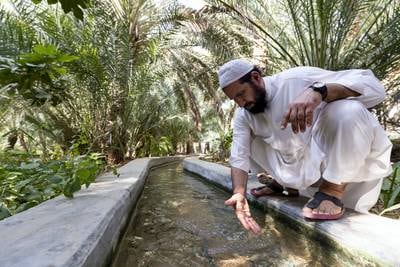

Photo: A farmer dips his hand into a falaj irrigation channel at Al Ain oasis. These Iron Age networks and now complemented by recycling, desalination and conservation strategies that can ease the strain being placed on groundwater supplies by growing populations. Chris Whiteoak / The National
…in the region where water stress is most acute … strategies are emerging to conserve this vital resource.
No visit to the Emirati city of Al Ain is complete without a trip to its oases, where farmers tend to thousands of date palms, fruit trees and fodder crops that are made possible by a system of aflaj – Iron Age irrigation channels that have been included in Unesco’s Representative List of the Intangible Cultural Heritage of Humanity. This ingenious collection of complex underground and surface channels is an engineering marvel, but it also reveals how the importance of fresh water is imprinted not just on the landscape but in the hearts of the people.
The persistence of the falaj networks shows what many in the Middle East have understood for centuries: that the struggle for clean water is a life-or-death one. That is why many in this region will be alert to the conclusions of a new global study of 1,700 aquifers, which say that groundwater is rapidly declining around the world, often at accelerating rates. The three-year survey by researchers at the University of California Santa Barbara found that groundwater levels are dropping in more than two thirds, or 71 per cent, of the aquifers examined.
In some arid countries, such as Iran, groundwater declines are already widespread. The strain put on groundwater resources by agriculture and growing human populations adds to the water scarcity facing many states in the Middle East. But if the region is where the struggle for water is most acute, it is also the place where more innovative ways of managing water resources are emerging.
The report’s authors highlight how in some parts of Saudi Arabia, groundwater levels that had been affected by agricultural irrigation had stabilised, or even recovered. “There is emerging evidence that these declines may be slowing down in central Saudi Arabia following policy changes,” co-lead author Scott Jasechko, an associate professor at UC Santa Barbara, told The National.
The UAE has always been acutely aware of the precarious nature of water security. In 2017, the country launched its Water Security Strategy 2036. Among the plan’s objectives were the need to reduce total demand for water resources by 21 per cent, to increase the reuse of treated water to 95 per cent and to increase the country’s national water storage capacity to two days’ worth. It also identified key challenges such as the depletion of groundwater, high demand, high water consumption per capita and water losses due to efficiencies in both irrigation and in the use of treated water.
Since then, approaches to water conservation have been refined, leading to some impressive wins. Earlier this month, it was announced that the Abu Dhabi Agriculture and Food Safety Authority is to supply recycled water to more than 1,600 farms in the emirate, noting that “recycled water is one of the important and necessary options to reduce pressure on groundwater resources”.
UAE campaigns to conserve water have also appealed to residents at the household level. In 2020, the Abu Dhabi Department of Energy developed the Use It Wisely app to help users minimise water and energy consumption at home. In Dubai, DEWA’s Smart Living programme lets customers receive alerts when their water use is high, and helps people compare their […]
Full article: www.thenationalnews.com
Clean water is essential for life, yet millions of Americans unknowingly consume contaminants through their…
Human brains contain higher concentrations of microplastics than other organs, according to a new study, and the…
From the Office of the Governor: In anticipation of a multi-day, significant atmospheric river in Northern California,…
From Governor Newsom: Scientists, water managers, state leaders, and experts throughout the state are calling…
Photo: A harmful algal bloom in Milford Lake, Kansas, made the water appear bright green.…
An expanded plastic foam coffee cup is at a donut shop in Monterey Park, California.…